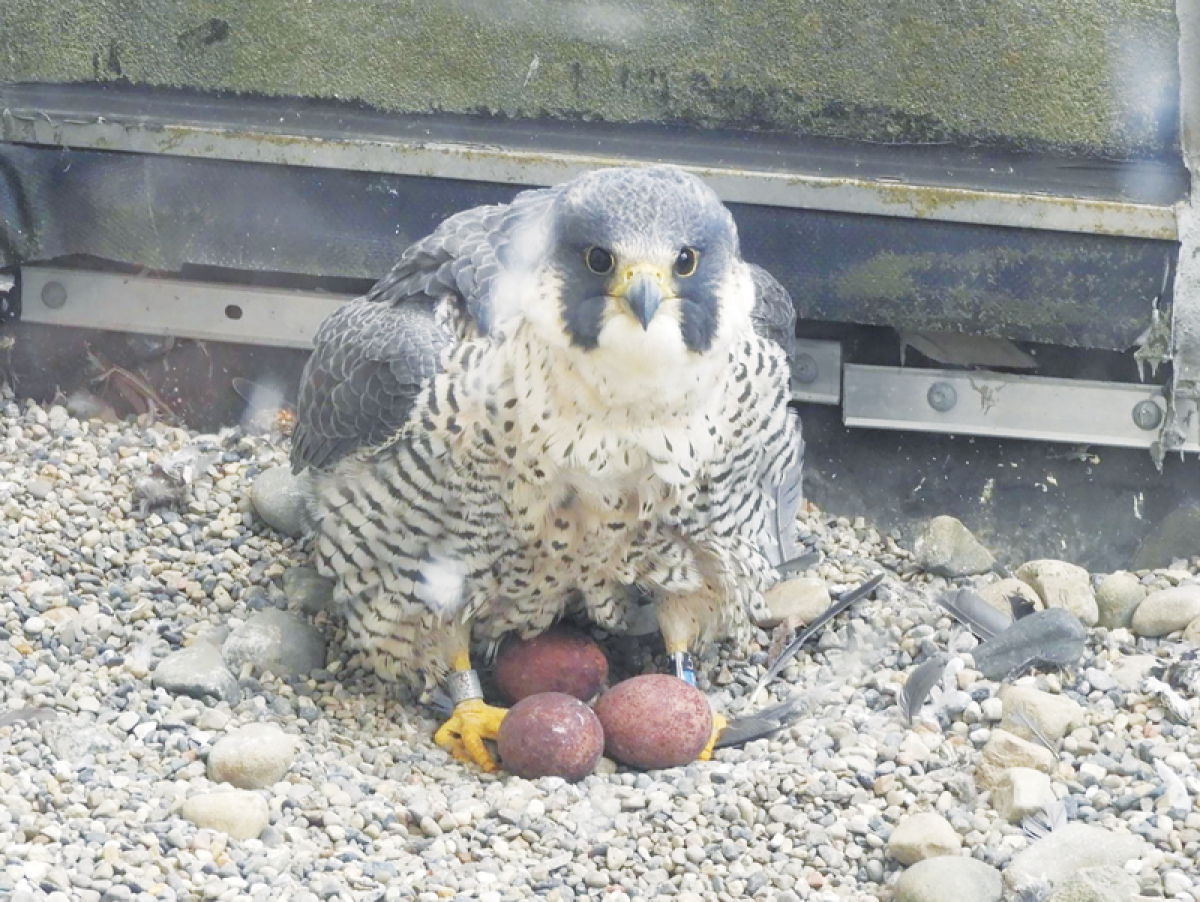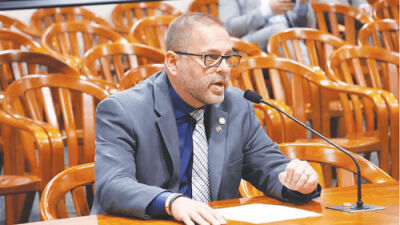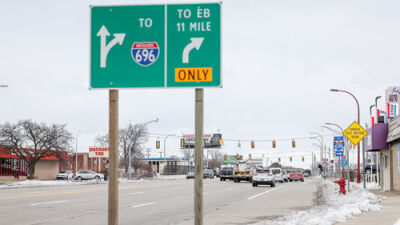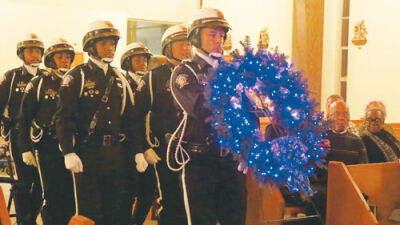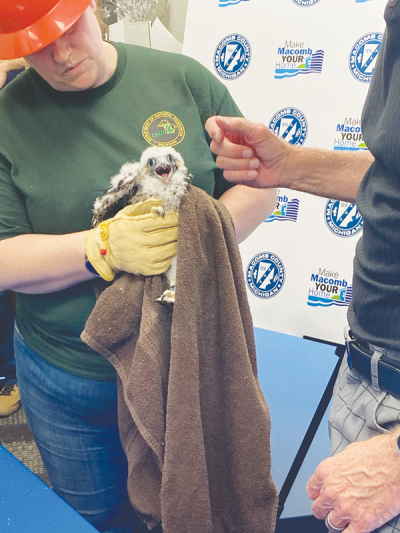
Danielle Durham, DNR peregrine falcon nest coordinator, holds peregrine falcon chick Gabe during his banding. Gabe hatched in May 2024 as one of four eggs under Brookie Cookie’s watch at the Old Macomb County Building in Mount Clemens.
Image provided by Macomb County
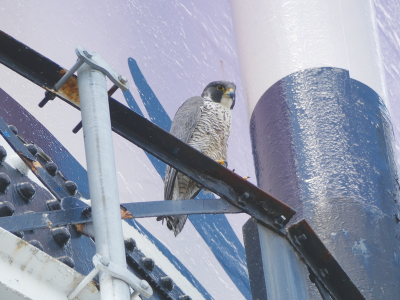
A peregrine falcon sits on a railing at the Detroit Zoo water tower. The tower has supported nests over the years with some disruptions caused by maintenance.
Image provided by Kayla Niner
METRO DETROIT — Over the weekend of Memorial Day, a very delicate ecological operation took place.
Two peregrine falcon chicks were removed from a nest at Detroit Metropolitan Airport and rehomed within Mount Clemens’ Old Macomb County Building. The chicks were located in a spot that would have put both them and humans at the airport in danger, forcing the Michigan Department of Natural Resources’ hand to undertake the risky rehoming.
“The DNR generally doesn’t want to do this, to foster and rehome,” said Danielle Durham, DNR peregrine falcon nest coordinator. “It was kind of an experiment … The (foster parent falcon) pair could not accept them. Luckily their maternal and nurturing instincts are high, and they just want to do what they do and raise chicks and rear young, but they could easily not have accepted those chicks.”
Indeed, it went well and the two birds, later named Dorothy and Bonner (in honor of Dorothy and Bonner Upshaw,) joined the recently hatched falcon chick, Gabe (named in honor of Gabe Anton), under the care of the ever-dutiful mother falcon, Brookie Cookie, at the county nest above Mount Clemens. The rehome occurred not long after the DNR fitted Gabe with tracking bands, making him the first Mount Clemens falcon chick to receive bands since 2016.
Between rehoming and fostering, the DNR shows a deep interest in the survival and care of the peregrine falcon. That’s for good reason: The bird has historically been on the endangered and threatened species lists in Michigan and across the United States.
Peregrine falcons are native to Michigan, making their home along the cliffs of Lake Superior and Isle Royale. Recently, peregrine falcons have found homes among the “pseudo cliffs” of skyscrapers and water towers. Though the birds are traditionally migratory, falcons that make their homes in cities have little need to migrate. Durham says peregrine falcon migration is food-based, and cities supply the raptors with “copious amounts” of prey year-round.
The ability to work within the human-built environment allowed peregrine falcons to thrive and gave birders a chance to see a dynamic bird in action.
“On October 4, 1993, Ruth Glass arranged a Macomb Audubon field trip to the Book Building in Detroit to meet with Judy Yerkey, a peregrine falcon nest monitor for the Michigan DNR,” Barb Baldinger, a long-time birder in southeastern Michigan, said via email. “We were able to see where the peregrine falcons were nesting and saw one of them fly to the nest. Knowing how rare peregrine falcons were at the time, it was very exciting!”
Peregrine falcons are commonly known as the fastest animals on Earth, capable of reaching over 200 mph and up to 240 mph in a dive. The high speeds peregrines are capable of can produce magnificent hunting scenes, alongside other daring maneuvers the bird can pull in flight.
“I have observed peregrine falcons catch their prey in the air as well as defend their territory by chasing off birds larger than themselves,” Baldinger said via email. “On several occasions, I watched a peregrine falcon fly under a turkey vulture, grab it by the talons and flip it upside down.”
There was, however, a major problem. The pesticide DDT killed raptors all across the United States. DDT would accumulate in the fat of prey animals, building more and more as prey was consumed by animals higher up the food chain. Small animals may be able to withstand the DDT, but larger animals were less resilient to the pesticide.
“As they continue to eat it accumulates in their system, and in the case of their peregrines and the ospreys and the bald eagles, it affected their ability to reproduce,” Durham said. “They would lay their eggs, but the eggshell would be thin, and when they would go to incubate the eggs, they would crush the eggs. You were not having new eggs hatched, so you were not having new peregrines added to the population and the old ones were still dying.”
DDT contamination decimated peregrine falcon populations, which reached record lows in the 1960s and several subspecies of peregrine falcon were declared endangered in 1970 under the Endangered Species Conservation Act of 1969. Peregrine falcons were all but extinct in the Michigan wilderness.
Responding to DDT pollution and its poisoning of birds took multiple forms across various levels of governmental agencies. Federal endangered species protections offered some aid to the raptors, while the Environmental Protection Agency banned DDT for most uses in 1972. At the state level, reintroduction efforts sought to kickstart the rebound of affected raptors. Baldinger says Canada began its reintroduction efforts in Ontario in 1977. The Michigan DNR reintroduced peregrine falcons between 1986-1992.
Banding falcons, placing metal bands with alphanumeric codes around the legs of the birds, is an essential part of tracking the growth of Michigan’s peregrine falcon population. Bands are color-coded and are based on which agency banded the bird — the silver bands are federally-owned, and the colored bands are the Michigan DNR’s — and people who spot the bands can report the codes to the appropriate agency. Bands allow wildlife management to track a bird throughout its life; with Brookie Cookie’s bands — black/blue, 52/K — we know she was hatched in the North Quad Tower of the University of Michigan in Ann Arbor in 2019.
“Being successful in reading the band numbers on individual peregrine falcons is a challenge,” Baldinger said via email. “You may spend nearly an hour staring into a spotting scope, waiting for the bird to scratch its face, preen its feathers, or lift its feathers in takeoff for flight, before you get a fleeting look at the band. Sometimes, it takes several visits of trying to get the ID. It is very exciting to discover that a new adult at a nesting location is one that is one that previously hatched in our local area.”
Bans and bands have helped the peregrine falcon population rebound. Only the Eurasian subspecies remains on the U.S. Fish and Wildlife Service’s endangered species list, while peregrine falcons are listed as threatened.
“I have actually seen a trend recently in the last couple of years where I’ve seen fewer banded birds at my nest sites than I do banded birds,” Durham said. “So that’s a good thing to see that they’re really recovering and able to reproduce without us. These are truly wild birds. These aren’t ones that we’re touching, and they’ve rebounded wonderfully.”
So wonderful has the peregrine falcon’s rebound in Michigan been that the future of the banding program is in jeopardy. Federal delisting and a reduction from endangered to threatened at the state level combined with the sightings of birds without bands all contribute to the idea that the peregrine falcon can thrive on its own once again. An MSUToday article from June 3 notes the 2024 DNR bandings at Spartan Stadium are likely to be the last ones performed there.
“That’s good news for peregrine conservation,” Durham said. “They’ve met all of the criteria to be removed from that endangered status, which is wonderful.”
Durham says the peregrine falcon population is stable in Michigan and will likely remain so for years to come thanks to the existing protections and learning from the mistakes of DDT overuse.
Raptors on camera
With peregrine falcons taking up nests on buildings, a number of cameras have been set up to document their lives and the development of falcon chicks.
Falcon nest cameras in the Metro Detroit area include:
• Warren nest, 30400 Van Dyke Ave, Warren, warrenperegrinefalcons.com/streaming-and-chat
• Wayne State University Old Main Building nests, 4841 Cass Ave., Detroit, clas.wayne.edu/falcons
• Old Macomb County Building nest, 10 N. Main St., Mount Clemens, macombgov.org/peregrine-falcons-macomb-county
• Jackson County Building nest, 120 W. Michigan, Jackson mijackson.org/Falcon
Falcon bands that are spotted can be reported to reportband.gov through the United States Geological Survey. If the website is not working, email bandreports@usgs.gov.
 Publication select ▼
Publication select ▼